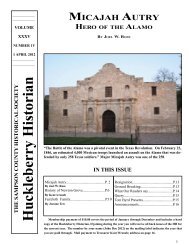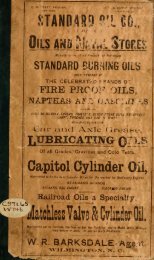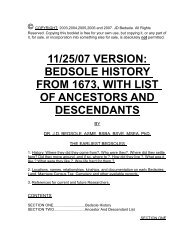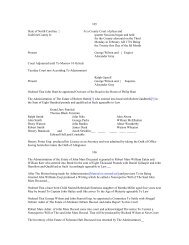Bedsole - NCGenWeb
Bedsole - NCGenWeb
Bedsole - NCGenWeb
Create successful ePaper yourself
Turn your PDF publications into a flip-book with our unique Google optimized e-Paper software.
After supper, the men watered the animals again and secured them for the night by tying them with “pigging<br />
strings” which were wires or ropes strung between two trees, or “hobbles” which simply means tying the feet<br />
of the animals together, to prevent them walking or running off during the night. The hobbles also served as a<br />
hindrance to any Indians who tried to make off with the animals, because the animals could not walk, or even<br />
trot. Knowing that Indians might steal their livestock, the wagonmaster assigned two shifts of night guards for<br />
the camp and the livestock for the night. Finaly, just before midnight, all people not working were asleep and<br />
the night sounds of crying babies, chirps of crickets and small animal sounds were all that could be heard.<br />
A small fire was kept burning all night in order to scare away the bigger wild animals. During the night, the<br />
mosquitos buzzed incessantly around the heads and in the ears of those trying to sleep. Some nights it<br />
rained all night and everything stayed wet, making the travelers more miserable than would otherwise be the<br />
case. With muddy trails, mosquitos, snakes, cold weather, rain, sick children, overturning wagons, lack of<br />
trails to follow, indians and things staying wet, the increased pain, misery and suffering quickly became a way<br />
of life. On any typical day, everyone on the wagon train was up at 4 a.m. and immediately set to work,<br />
repeating the jobs they had done the night before; Feeding and watering the animals, and filling all the water<br />
barrels while the women prepared breakfast, usually consisting of hoecakes, fried meat and coffee for<br />
everybody. Then the children had to be cared for and fed.<br />
After breakfast, everything had to be repacked, reloaded and lashed down on the wagons, the livestock had<br />
to be rounded up and kept together until the wagons began moving. The hunters went first. By the time the<br />
group was ready to go, most people were already tired from lack of sleep and from all the work that had been<br />
done at the beginning of the day. The night guards had most of the day to try for some sleep, but that was<br />
not easy on a loud, bumpy and very uncomfortable wagon. Finaly, with the wagon train on the move, the<br />
loose livestock were a huge problem because of the little control the settlers were able to exercise over them.<br />
Keeping them on the trail of the wagons required constant chasing, steering and caring for them all day.<br />
Along the way, they passed a few outposts and supply/trading posts which were built of logs and occupied<br />
usually by previous settlers who found living along the route to be a little easier by buying, selling and trading<br />
goods such as tools, weapons, animal hides and edibles from the Indians and other settlers, and the passing<br />
wagon trains. In the absence of money, the trade of goods was the prevalent way of doing business. These<br />
outposts also served as sources of information to all travelers concerning other settlers, indians, forts, and<br />
directions, but most importantly, they provided information on Indian troubles and trouble spots such as trees<br />
down, trail washouts, stream crossings, or landslides, or large trees across the trails ahead<br />
HOW THEY LIVED<br />
Upon arriving at a new destination, the travelers learned that the government would sell frontier land at a low<br />
cost per hundred acres, with the stipulation that the buyer would clear and plant 3 acres of the land every<br />
calendar year, for every hundred acres received, up to a limit of about 260 acres per family, depending upon<br />
the number of people in the family. Prior to the establishment of local land offices, no limits existed on<br />
acreage for new settlers.<br />
From earlier settlers in the area, they learned that although the land was free, many of them worked as<br />
PAGE EIGHTEEN<br />
share-croppers, or at other work for various periods of time. Some worked as carpenters, wagon makers,<br />
“coopers” (barrel makers/carpenters), seamstresses, tailors, blacksmiths, shoe makers and so forth. But<br />
most worked as share-croppers and that means performing back-breaking, common labor, farming someone










